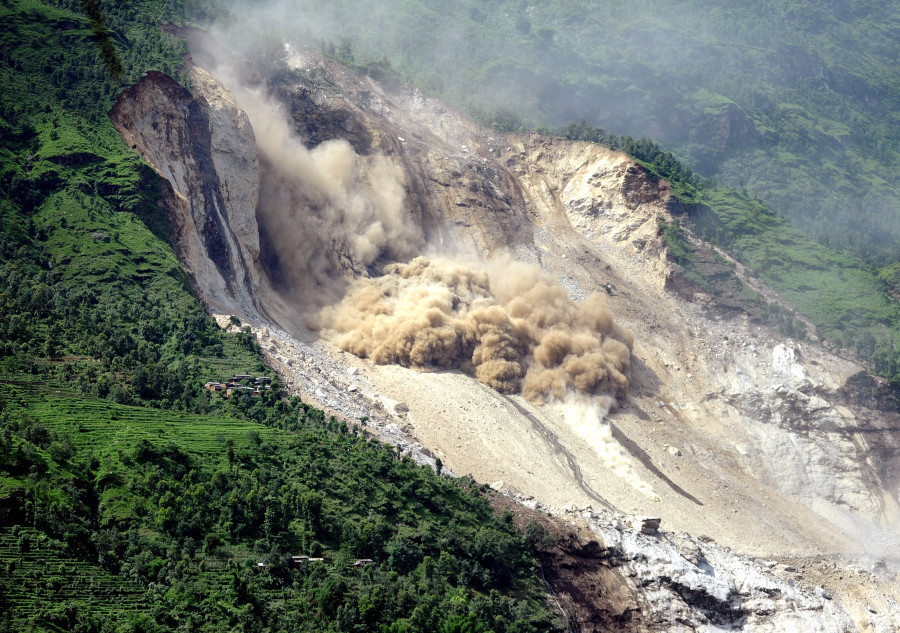Columns
Killer landslides
Our forefathers tackled landslides for centuries by building simple diversion channels.
Madhukar Upadhya
The images of people grieving over the death of their loved ones and the loss of everything, from income to stability to peace of mind, further underscores the devastation wrought by this year’s landslides. Homes were buried under mud or swept down by landslides as they slept. There was a tremendous loss of property as well. In fact, the scars of the landslides, new and old, on our mountains are a testament to Nepal’s propensity for such natural disasters. In addition, continued human interference by way of reshaping the land for economic benefit, often with no regard to how rainwater flows down mountain slopes, makes the outcomes not only unpredictable but also catastrophic. The fact that landslides kill more people than floods illustrates the increasing risk posed by these mishaps.
Although destructive from an anthropocentric perspective, we must bear in mind that landslides and erosion are part of complex natural processes of land formation that began with the rise of the mountains following the collision of tectonic plates. These processes will continue because they have an important role to play in nature—a role we generally take for granted. For example, had the soil from the Himalaya not been brought down continually by landslides and erosion and deposited by the rivers at the base for millions of years to form the Gangetic plains, the story of our land and the ecosystem, which sustained the growth of one of the oldest civilisations in the world, would have been vastly different.
Functions of landslides
Accordingly, landslides and erosion serve multiple functions which can range from land diversification to building habitats for spawning organisms, providing nutrients to aquatic plants and vegetation in near-shore ecosystems such as floodplains and marshes, to maintaining soil fertility by enriching them every year with sediment-laden floodwaters. Then there are other mysteries surrounding landslides which are beginning to come to light. One of them is how landslides also release and sequestrate carbon depending on the type of rocks they belong to.
The unavoidable truth is that landslides will continue to occur. However, they become a problem when they destroy lives and property, and impact our economic growth. Addressing our landslide problem isn’t as simple as one would like it to be because they occur across mountain ranges of different ages, from the youngest Siwaliks to the oldest high mountains. Latitude is another important factor because its difference from Ilam to Humla, when combined with an altitudinal variation of mountains, gives rise to complex climatological patterns within a short distance that are often not only poorly understood, but also responsible for significantly altering localised precipitation, which is one of the ingredients of landslides.
Even the onset and withdrawal of the monsoon isn’t the same across the country. It’s gradual along the central and eastern mid-hills and rapid in the western hills. Similarly, precipitation patterns in the eastern Tarai, eastern high mountains and western Siwaliks are complex with no dominant pattern, which makes analysing rainfall trends to detect the probability of landslides even more difficult.
The complexity of landslides has never been as revealing as this year. Although they were all triggered by high-intensity rain—a trend on the rise due to global warming—and in areas with favourable geological conditions, from the perspective of their origin, we witnessed at least five different types of landslides which caused unprecedented damage. Landslides in Barekot, Jajarkot originated from farmlands while in Lidi, Sindhupalchok, the damage was caused by a structural failure in the slopes above the village.
In Parbat and Tanahu, the massive debris flow originated from a forested area above the villages. In Baglung, a combination of landslides and a series of landslide-blocked-lake-outburst floods swept away 76 houses. Similar were the cases in Achham and Bajhang. In Marang, Myagdi, the debris deposited in the existing gullies during road construction flowed down causing devastation in the heavy rain. These are only a few examples of major landslides this year with fatalities. There are thousands of others which occur each year—albeit with no deaths—that leave behind a trail of destruction to farms, crops, livestock, roads, bridges and so on.
Regarding the damage, two schools of thought have dominated the discourse. The first dictates relocating settlements to avoid vulnerable areas. Although sound in logic, this may not be feasible across the board because most settlements are located on landslide-deposited debris that is inherently unstable, and relocating would require large areas. Providing livelihoods is another issue. The second postulates trying to fix the problem with the construction of physical defence mechanisms such as engineering structures. They can be justified along the roads to ensure they remain in operation at all times; but not in areas beyond the road corridors where communities live and make their living, merely because of the cost.
These complexities have already made tackling landslides one of the most difficult conundrums for our experts. Moreover, the effects of climate change on landslide risk will continue to rise. Unfortunately, we lack the resources and the required expertise to analyse how climate change will affect localised precipitation patterns which would subsequently result in meteorological and environmental consequences that are likely to be further difficult to comprehend.
Learn from our forefathers
All this boils down to the fact that the challenge is enormous, and that we will continue to face unprecedented events in the years ahead. We can’t go on building expensive structures beyond the reach of communities. We can’t ignore the problem altogether after initial emergency responses either. Therefore, effective risk reduction approaches must be developed and applied.
In view of predicted climate change-led meteorological consequences, maybe it’s time to think outside the box and explore the ways in which our forefathers tackled landslides for centuries to save themselves and their source of livelihoods—the farms. One such strategy is what Brian Carson, a renowned soil scientist with extensive experience in land conservation, wrote in his highly quoted publication The Land, The Farmer and The Future (1992) upon observing what farmers in Lalitpur and Kabhre had done: By using simple diversion channels, the farmers have been able to stabilise previously active landslide areas and whole terrace systems. Some of these strategies may look clumsy or archaic through our modern glasses yet be within our reach and capacity to implement. Perhaps, that’s the way to go.




 11.12°C Kathmandu
11.12°C Kathmandu















